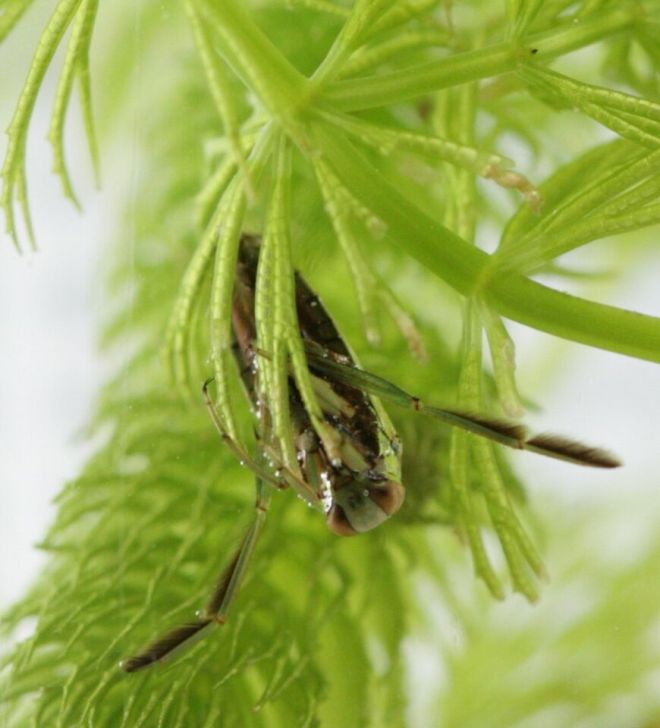By Celina Baines
Have you ever thought about what a pond-dwelling insect might do if it doesn’t like the pond it lives in? People generally assume that these insects are stuck where they are, but actually, many freshwater insects have wings and can fly. This movement between ponds is an example of a process known as dispersal.
Backswimmers, for example, are insects that live in ponds and streams (and sometimes even swimming pools!). Backswimmers have a characteristic way of swimming – on their backs, just under the surface of the water, using their hind legs to propel themselves. It makes them look a little like they are doing the backstroke (hence their common name!). But they also have wings, and can fly between ponds.

A top view of a backswimmer swimming. Backswimmers can often be seen swimming just under the surface of the water, ventral side up. Photo credit: Shannon McCauley.
We know from observing these insects that not all backswimmers make the same decisions about whether to disperse. Some individuals spend their whole lives in the ponds they are born in, and some individuals move to new ponds. So why do some individuals stay and some leave? One factor that could influence dispersal decisions is the quality of the pond. Pond “quality” could depend on many things, including the risk of being eaten by predators like fish. Dispersing can be a great way for organisms to avoid habitats that will be bad for them or their offspring.
Once a backswimmer has decided that it wants to disperse, it then has to decide whether it is strong and healthy enough to fly. This could be another factor that determines whether an individual decides to stay or go.
In the summer of 2013, I conducted a field experiment to learn more about how backswimmers make dispersal decisions. I wanted to test whether dispersal was induced by fish. I also wanted to test whether body condition (basically, the general strength and health of an organism) influences dispersal decisions.
I started by collecting backswimmers from a pond at the Koffler Scientific Reserve. That’s a research site owned by the University of Toronto, where I’m a graduate student.

This is me collecting backswimmers from a pond at the Koffler Scientific Reserve. Photo credit: Chris Thomaidis.
I brought the backswimmers back to a lab at the University of Toronto. Because I wanted to test the effects of body condition on dispersal, I first had to manipulate the backswimmers so that they had different levels of body condition. I did this by carefully controlling how much food each backswimmer got to eat.
Backswimmers are carnivores, and they aren’t very picky. For this experiment, I fed them fruit flies, because it’s really easy to get lots and lots of fruit flies. So, in what turned out to be one of the most back-breakingly tedious jobs I’ve ever performed for science, I (and many uncomplaining assistants) counted out thousands of individual fruit flies to feed to the backswimmers. Each backswimmer was housed in its own little cup, and received a specific (and carefully counted) number of fruit flies to eat every day. Here’s what the hundreds of drink cups looked like, colour coded and full of bugs.
After a few weeks of controlling the backswimmers’ diets, it was time to bring them outside to see if they would fly. I set up some artificial ponds in a big field. These “ponds” are actually just watering tanks that farmers use for cows and horses, but I added algae and artificial plants to make them more like natural ponds. Since I also wanted to test whether backswimmers are scared away by fish, I added a fish to half of the tanks. I put the fish in cages, and that way, the backswimmers could tell there was a fish in the tank (they could see and smell the fish), but the fish couldn’t actually eat the backswimmers.
Then I put the bugs in the tanks, and waited. After a couple days, I went back to the tanks and checked to see which backswimmers were still in the tanks, and which ones had flown away.
Firstly, I found that backswimmers are scared away by fish; they are more likely to disperse when a fish is in their pond.
I also found that the backswimmers with high body condition are more likely to fly, probably because they are strong fliers and have the best chance of successfully finding a new pond.
Both of these results were really cool and answered some questions for us about how backswimmers make dispersal decisions. But they might also tell us a little about how other organisms move around in natural ecosystems. Dispersers are the only individuals that can find new ponds and start new populations. If dispersers tend to be the strongest and healthiest individuals, that’s great for native species that we want to encourage to start new populations. But having strong, healthy individuals from exotic species start new populations is probably bad news. Dispersal can therefore have important consequences, which is why we need to understand more about how and why organisms disperse.
For more information about my study, check out the recent publication:
This post is also available in: Français









great article, research in dept and it made me curious. 🙂